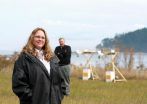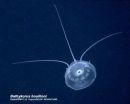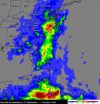A colony of moss, worms and various forms of shrimp flourishes in an area where the water is inky black, about 90 degrees Fahrenheit, and a cauldron of nutrients, gases and poisons, the researchers reported in the September issue of Geobiology.
The vent is close to 100 feet below the surface of Yellowstone Lake and a third of a mile offshore in the West Thumb region. The worms and shrimp live among approximately two feet of moss that encircles the vent.
"This particular vent seemed unique relative to all other active vents thus far observed in the lake in that it is robustly colonized by plants," the researchers wrote.
The team explored the lake bottom with a Remotely Operated Vehicle built by the same person who built a much larger rover for exploring the Titanic. The MSU team was led by John Varley in the Big Sky Institute and Tim McDermott and Bill Inskeep in the Department of Land Resources and Environmental Sciences and MSU's Thermal Biology Institute.
The researchers said that the Fontinalis moss is not known to grow in the conditions they found on the floor of Yellowstone Lake and that a worm found associated with the moss had never been reported in North America. The researchers also noted that this was the first in-depth published study of the biology associated with any geothermal vent in Yellowstone Lake.
"The proliferation of complex higher organisms in close association with a Yellowstone Lake geothermal vent parallels that documented for deep marine vents, although to our knowledge this is the first such documentation for a freshwater habitat," the researchers wrote in Geobiology.
The vent is evidently responsible for the moss being able to live in what humans perceive as total darkness, but these plants obviously have the ability to somehow find and use very low light, Varley said. At times, the scene around the vent looks like it belongs in a snow globe because of a beige-colored silica and aluminum mineral that flies out of the vent and settles on the moss, which further lessens the ability of the moss to acquire light that is essential for it to photosynthesize. Key to the survival, indeed proliferation, of this moss in this unusual environment are the nutrients contained in the vent water. The nutrients feed the moss, which feed the shrimp and worms. The vent water also contains toxins such as arsenic and cadmium. It's super-saturated with carbon dioxide, hydrogen and other gases.
"If there are gases of that type anywhere else in Yellowstone, it follows that there would be life that has been introduced and evolved there that uses those resources," Varley said.
The researchers explored the bottom of Yellowstone Lake from onboard the R/V Cutthroat, a National Park Service boat, Varley said. Using a map created by Lisa Morgan with the U.S. Geological Survey, they noted that the lake contains hundreds of active and dormant vents. Scientists have mapped the lake bottom three times over the last 136 years, but studies of the biology around the vents have been extremely limited.
The vents are mostly on the northern half of the lake, inside the Yellowstone caldera, and span from the West Thumb region to Mary Bay. The lake bottom is probably the third largest geothermal field in the park. It is estimated to contribute 10 percent of the total geothermal output in the park, as well as 15 percent of the water that's in Yellowstone Lake, Varley said.
Despite the geothermal activity, the lake is "still one cold son of a gun," Varley said, noting that the waters' surface rarely gets above 64 F.
Researchers used a Remotely Operated Vehicle specially designed for the task by Dave Lovalvo of Eastern Oceanics Research. About half the size of a household refrigerator, the ROV is much smaller than the ROVs he built for exploring deep ocean environments, but it can do most of the same sampling, Lovalvo said. ROV's for deep ocean exploration can range from 1,000 pounds to almost 10,000. The ships that carry them are typically 225 to 300 feet long. The ROV for Yellowstone Lake weighed about 250 pounds. The R/V Cutthroat is about 28 feet long.
"I'd like to think that this (ROV) has and will continue to assist the National Park Service and the public in not only better understanding this truly amazing place, but also preserving it for future generations," said Lovalvo, who has been involved in Yellowstone research for 25 years.
Although he built rovers to explore the Titanic; the PT-109 boat made famous by former President John F. Kennedy; and features deep in the ocean, Lovalvo said he is committed to Yellowstone.
"Yellowstone is a very unique environment and one of the few places in the world where one can compare an inland, hydrothermally active lake to an active volcanic area of the ocean," he said.
The study produced other results that will be the focus of future scientific papers, Varley said. The researchers are currently writing five papers about their findings.
The Geobiology paper compared each vent to an island with its own chemistry and conditions. Future research may focus on genetic communication between those islands, Varley said.
Other MSU team members on the Yellowstone project were Rich Macur in the Inskeep lab; Scott Clingenpeel, a postdoctoral researcher with McDermott; and Stephanie McGinnis, a conservation biologist with the Big Sky Institute. Team members from elsewhere were Lovalvo; Janice Glime from Michigan Technological University and K. Nealson from the University of Southern California and the JC Venter Institute in California.
Yellowstone National Park is required to document the park's biodiversity, and the broader study being conducted by MSU at least doubles the list of organisms known to live there, Varley said. He added that understanding how the colony lives in such extreme conditions may lead to the development of new products and inventions.
One example of a Yellowstone organism leading to an industrial product is Thermus aquaticus, a heat-resistant micro-organism discovered in a Yellowstone hot spring in the 1960s. Subsequent research on Thermus aquaticus led to today's modern DNA testing -- a multi-billion dollar industry.
The project at the bottom of Yellowstone Lake has already benefited public school teachers and National Park Service employees who helped conduct field work that contributed to the study, Varley said. Not only did they learn field techniques, but they will share their experiences and scientific findings with students and park visitors.
Varley, who used to work for the National Park Service and ended his NSP career as director of the Yellowstone Center for Resources, said he started inventorying the park's biodiversity in 2003. Now a senior scientist at the Big Sky Institute, Varley said the study that led to the current discoveries began in 2004 as a pilot project. Field work continued in 2008 and 2009, with each field season lasting about 10 days during the fall. The ROV was used during the pilot season and both field seasons.
"What we do is impossible without the ROV," Varley said. "There is no other feasible way to do the work."
### The MSU study was funded primarily by a grant from the Gordon and Betty Moore Foundation. Additional funding came from the National Park Service Centennial Challenge Match Program.
END





